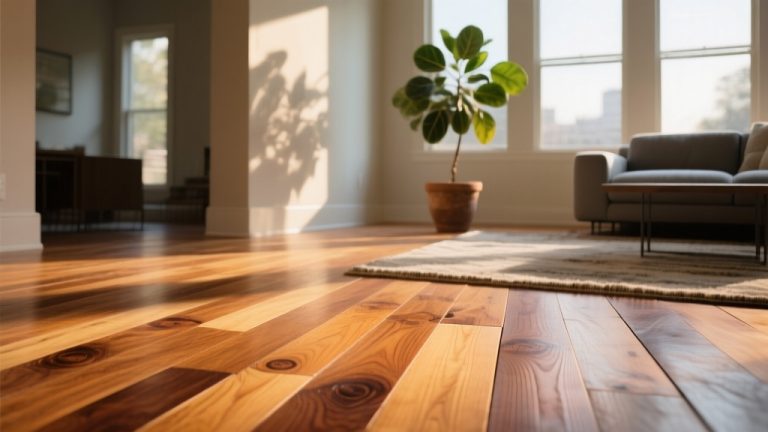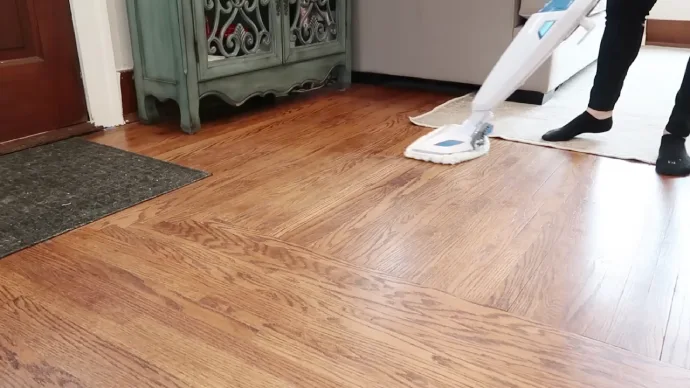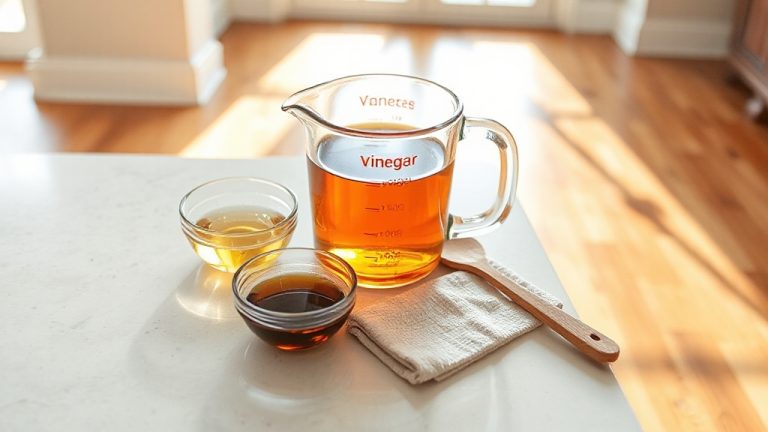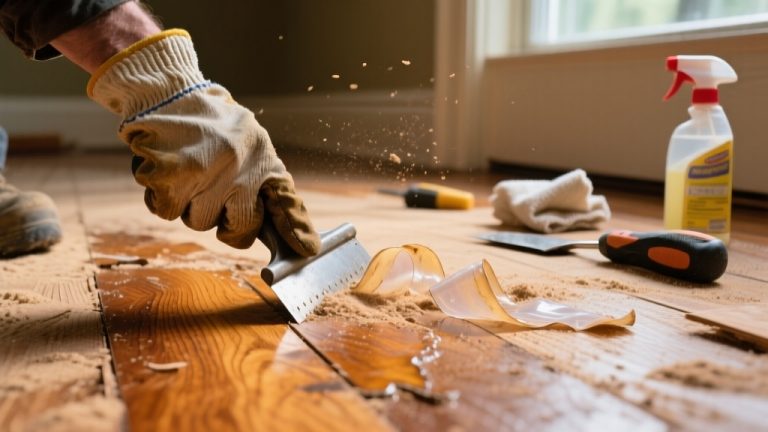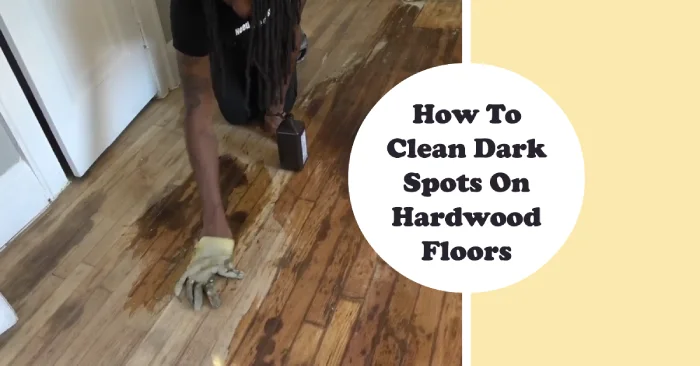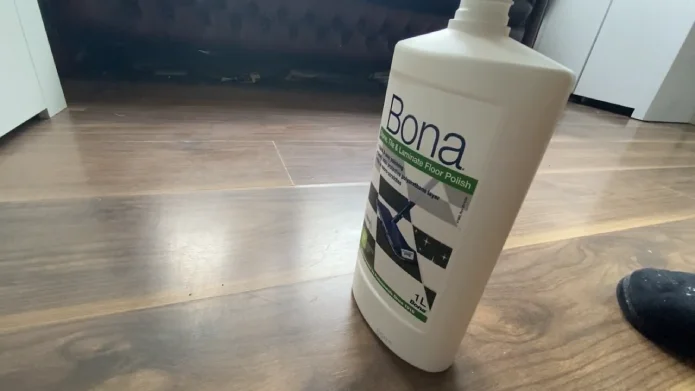You’ll want to start by testing for asbestos in old linoleum, especially if installed before the 1980s, to guarantee safety. Gather tools like a utility knife, scraper, heat gun, and protective gear.
Score the linoleum into sections, soften the adhesive with heat, then carefully pry up each piece without harming the hardwood. Use solvents or warm towels to remove residual adhesive, clean debris thoroughly, and dispose of waste per regulations.
Following these steps protects your floor and health; more detailed guidance will help you master the entire process.
Key Takeaways
- Test linoleum for asbestos if installed before the 1980s and follow safety regulations for removal and disposal.
- Score the linoleum into manageable sections with a utility knife to avoid damaging the hardwood floor beneath.
- Apply heat with a heat gun or hair dryer to soften adhesive, then pry up linoleum sections carefully with a scraper.
- Remove adhesive residue using heat, plastic scrapers, and appropriate solvents tested on hidden areas to protect the wood.
- Clean debris thoroughly, vacuum dust gently, and dispose of waste according to local guidelines, wearing protective gear throughout.
Assessing Safety Risks and Preparing the Work Area
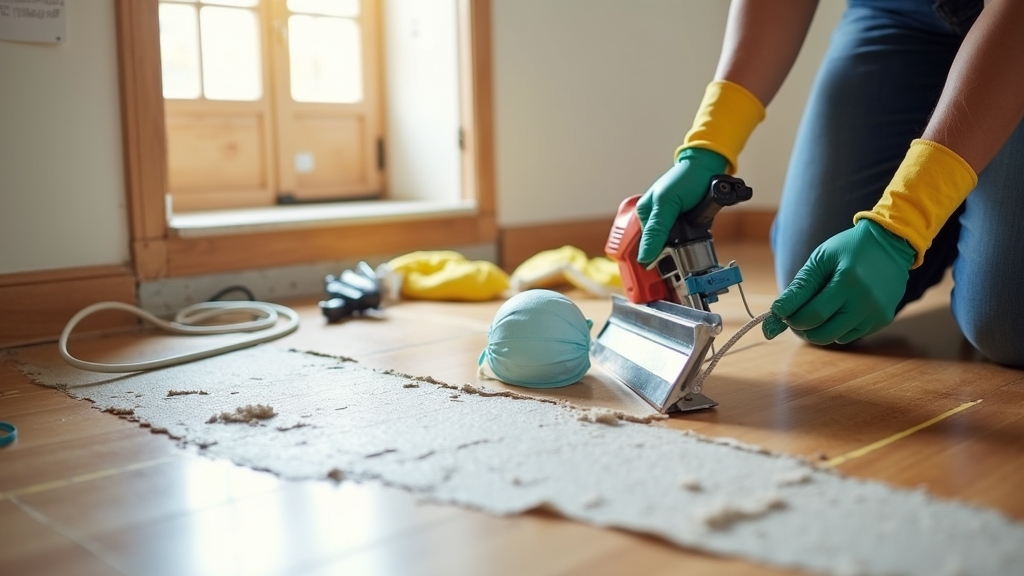
Before you remove old linoleum from hardwood floors, you need to assess potential asbestos risks and prepare the work area meticulously. Linoleum installed before the 1980s may contain asbestos fibers, which become hazardous if disturbed.
Test the flooring for asbestos using a professional service to confirm presence and concentration. Since asbestos fibers are released mainly during installation or renovation activities, it is crucial to handle the removal with extreme care. Maintain moisture control during removal to prevent airborne particles from spreading.
If asbestos is detected, follow local regulations, which often require licensed removal. Next, restrict access by establishing clear boundaries and posting signage. Seal off the work area with plastic sheeting on floors and walls, and close HVAC vents to prevent fiber spread.
Equip yourself with proper PPE: disposable suit, gloves, goggles, and an asbestos-approved respirator. Wet the surface during removal to minimize airborne fibers. Prepare labeled disposal containers onsite for immediate containment of asbestos waste after removal.
Tools and Materials Needed for Linoleum Removal
A successful linoleum removal hinges on having the right tools and materials at hand. You’ll need a utility knife for scoring, a putty knife or floor scraper to lift linoleum, and a flat pry bar to carefully raise edges without damaging the hardwood.
Pliers and chisels assist in stubborn areas and detailed corners. Equip yourself with work gloves, knee pads, sturdy shoes, a face mask, and eye protection for safety. Before starting, clear the area of furniture and belongings to create a safe workspace.
Ensure proper ventilation in the workspace by opening windows and doors for fresh air circulation. For efficiency, a heat gun or power floor scraper softens adhesive and speeds removal.
Adhesive removers, steamers, and various scrapers help clean residue, while cleaning cloths wipe the floor afterward. Optional gear includes extension cords, garbage bins for waste, and dust containment equipment.
Step-by-Step Process for Removing Old Linoleum
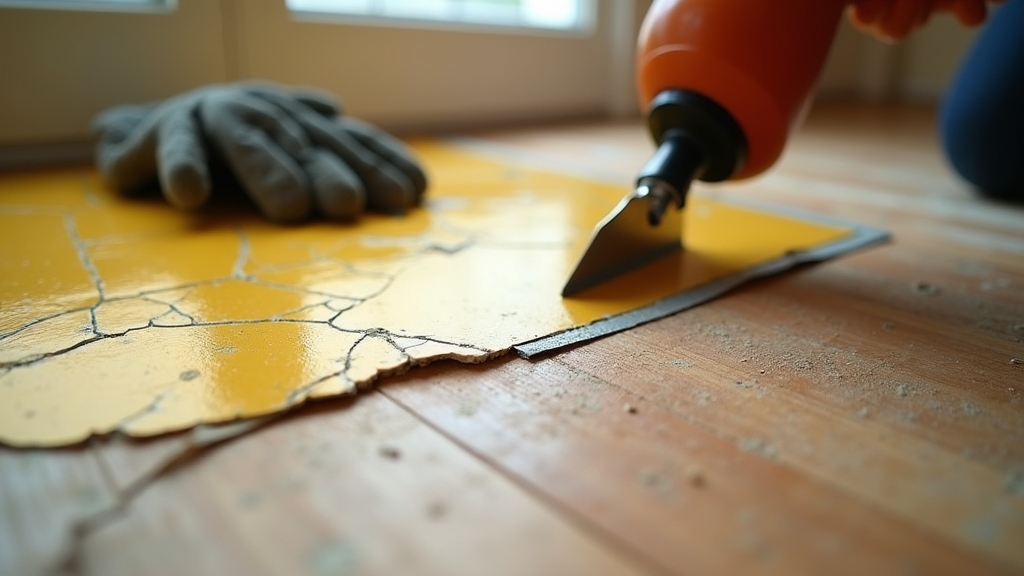
Once you clear the room and remove baseboards, you’ll prepare the workspace for linoleum removal by ensuring good ventilation and organizing tools within reach. It is also important to disconnect water and electrical lines if you are moving any appliances before starting.
Proper preparation can reduce the risk of damage and ensure a smoother refinishing process by protecting the wood underneath from unnecessary wear.
Follow these steps for efficient removal:
- Score and Section: Use a sharp utility knife and a straight edge to cut the linoleum into 12 to 24-inch strips, cutting through the adhesive but avoiding hardwood damage.
- Apply Heat: Warm each section with a heat gun or hair dryer for about 15 seconds to soften the adhesive, moving the heat source continuously to prevent burning. This step helps in loosening the adhesive effectively, which is crucial before sanding hardwood floors.
- Lift and Scrape: Starting at an edge, pry up each heated strip with a power scraper or heavy putty knife, working systematically to remove all linoleum pieces without damaging the floor beneath.
Techniques for Removing Adhesive and Mastic Residue
Though removing old linoleum strips clears the surface, stubborn adhesive and mastic residues often remain bonded to the hardwood. To tackle these, start by softening residues with controlled heat using a heat gun or hair dryer, moving constantly to avoid finish damage.
Ensure the wood finish can tolerate heat before applying any heat source to prevent damage. Always wear personal protective equipment such as gloves and goggles, and ensure the area is well-ventilated when using heat or chemicals. Once softened, gently scrape with plastic or wooden spatulas, avoiding metal tools to prevent scratches.
For persistent residue, apply acetone or a wood-safe adhesive solvent with a brush, allowing penetration; test solvents on hidden spots first. Use gloves and ensure proper ventilation. You can also soften water-based adhesives by applying hot, damp microfiber towels, then wipe repeatedly.
Finish by wiping with microfiber cloths to remove all residue without abrasion. Always assess your floor’s finish type and test methods to avoid irreversible damage. Additionally, using a plastic scraper rather than metal tools helps protect the hardwood surface during residue removal.
Proper Disposal and Post-Removal Cleanup Procedures
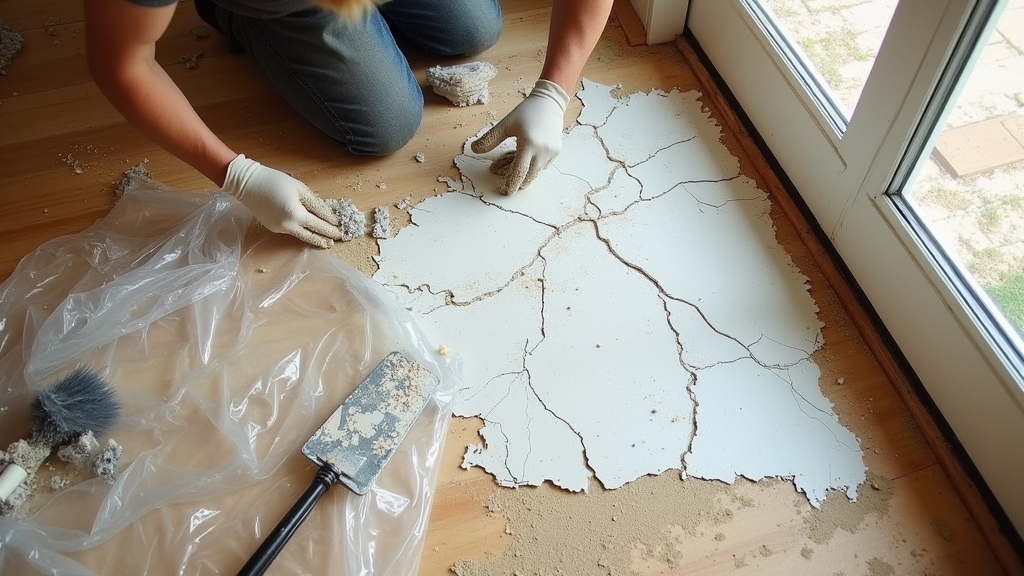
After removing old linoleum, you must handle disposal and cleanup carefully to comply with local regulations and protect the environment.
First, thoroughly clean flooring scraps to remove dirt and separate them from other waste. Many local facilities accept small quantities of linoleum for recycling or disposal. It is also important to vacuum hardwood floors gently after removal to eliminate fine dust and debris without damaging the surface.
Second, identify any asbestos-based adhesives; these require special disposal and can’t be recycled. Third, use appropriate protective gear during cleanup to avoid exposure to residues or dust.
For disposal: contact local recycling centers or waste management facilities for accepted flooring materials and potential tipping fees. Donate intact flooring to charities or repurpose scrap pieces for DIY projects to reduce landfill waste.
Avoid burning vinyl due to toxic emissions; instead, use waste-to-energy facilities if available. Complete cleanup of floors and surroundings minimizes residual chemical risks and prepares your hardwood for restoration.
Frequently Asked Questions
Can I Install New Flooring Directly Over Old Linoleum?
You can install new flooring directly over old linoleum if it’s in good shape, with no major damage or asbestos underneath. Just make sure it’s clean, dry, and firmly adhered.
Use an underlayment to cushion and smooth out any imperfections. Thicker vinyl planks work best to hide bumps. Keep manufacturer guidelines in mind and consider a floating floor system to make future removal easier.
Don’t try to cover uneven surfaces, as this can cause problems down the line.
How Do I Test if Linoleum Contains Asbestos?
To test if your linoleum contains asbestos, carefully collect small samples from all layers—flooring, adhesive, and underlay—while wearing PPE like an N100 mask and gloves.
Place each sample in separate airtight bags, label them, and send them to a certified lab for microscopic analysis. Avoid disturbing the floor to prevent fiber release.
If you’re unsure, use at-home kits or hire professionals to guarantee safe and accurate testing.
What Are the Health Symptoms of Asbestos Exposure?
You might experience shortness of breath, persistent dry cough, chest tightness, or pain after asbestos exposure. Early signs include fatigue and hoarseness, progressing to severe respiratory issues, weight loss, and finger clubbing.
Diseases like asbestosis, lung cancer, or mesothelioma cause overlapping symptoms, complicating diagnosis. Symptoms often appear decades later, so if you’ve been exposed, watch for these signs and consult a healthcare professional promptly for evaluation and management.
Is Professional Asbestos Abatement Always Necessary?
Think of asbestos abatement like defusing a ticking bomb—you can’t just walk away or improvise. You don’t always need professional abatement, but whenever asbestos-containing materials exceed regulatory thresholds, are damaged, friable, or disturbed during renovations, you absolutely must hire licensed experts.
They follow strict protocols, use specialized equipment, and guarantee safety and compliance. Skipping professionals risks severe health hazards and legal consequences. Always prioritize certified abatement when asbestos is confirmed or suspected.
How Long Does Linoleum Removal Typically Take?
Linoleum removal typically takes several hours to multiple days, depending on your floor’s size, adhesive condition, and tools used. Cutting linoleum into strips and scraping adhesive manually extends the process. Using heat guns or chemical solvents accelerates it but still requires patience.
If asbestos-containing adhesive is present, removal takes longer due to safety protocols and possible professional involvement. Plan accordingly for prep, removal, and cleanup stages to ensure efficiency.
Smart Setup and the Right Tools Make All the Difference
You’ve successfully stripped stubborn, sticky linoleum, revealing radiant, raw hardwood beneath. By safely setting your space, selecting suitable tools, and systematically scraping surfaces, you’ve simplified a strenuous task.
Now, swiftly sweep and safely seal any stray residue to sustain your floor’s strength. Remember, removing remnants responsibly reduces risks and readies your room for renewal. Stay sharp, stay safe, and save your solid floors from stubborn, stubborn stains and sticky situations.

